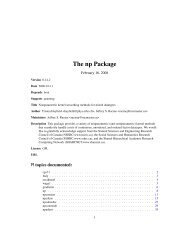16 juraNoteRock see book and belowCd see bookCo see bookCr see bookCu see bookNi see bookPb see bookZn see book<strong>The</strong> points data sets were obtained from http://home.comcast.net/~goovaerts/book.html, the grid data were kindly provided by Pierre Goovaerts.Rock Types: 1: Argovian, 2: Kimmeridgian, 3: Sequanian, 4: Portlandian, 5: Quaternary.Land uses: 1: Forest, 2: Pasture (Weide(land), Wiese, Grasland), 3: Meadow (Wiese, Flur, Matte,Anger), 4: Tillage (Ackerland, bestelltes Land)Points 22 and 100 in the validation set (validation.dat[c(22,100),]) seem not to lieexactly on the grid origininally intended, but are kept as such to be consistent with the book.Author(s)Data preparation by David Rossiter (rossiter@itc.nl) and Edzer PebesmaReferencesGoovaerts, P. 1997. Geostatistics for Natural Resources Evaluation. Oxford Univ. Press, New-York,483 p. Appendix C describes (and gives) the Jura data set.Atteia, O., Dubois, J.-P., Webster, R., 1994, Geostatistical analysis of soil contamination in theSwiss Jura: Environmental Pollution 86, 315-327Webster, R., Atteia, O., Dubois, J.-P., 1994, Coregionalization of trace metals in the soil in the SwissJura: European Journal of Soil Science 45, 205-218Examplesdata(jura)summary(prediction.dat)summary(validation.dat)summary(transect.dat)summary(juragrid.dat)# the commands to create the spatial objects:require(sp)jura.pred = prediction.datjura.val = validation.datjura.grid = juragrid.datjura.pred$Landuse = factor(prediction.dat$Landuse, labels=levels(juragrid.dat$Landuse))
krige 17jura.pred$Rock = factor(prediction.dat$Rock, labels=levels(juragrid.dat$Rock))jura.val$Landuse = factor(validation.dat$Landuse, labels=levels(juragrid.dat$Landuse))jura.val$Rock = factor(validation.dat$Rock, labels=levels(juragrid.dat$Rock))coordinates(jura.pred) = ~Xloc+Yloccoordinates(jura.val) = ~Xloc+Yloccoordinates(jura.grid) = ~Xloc+Ylocgridded(jura.grid) = TRUEkrigeSimple, Ordinary or Universal, global or local, Point or Block Kriging,or simulation.DescriptionUsageFunction for simple, ordinary or universal kriging (sometimes called external drift kriging), krigingin a local neighbourhood, point kriging or kriging of block mean values (rectangular or irregularblocks), and conditional (Gaussian or indicator) simulation equivalents for all kriging varieties, andfunction for inverse distance weighted interpolation. For multivariable prediction, see <strong>gstat</strong> andpredict.<strong>gstat</strong>krige(formula, locations, ...)krige.locations(formula, locations, data, newdata, model, ..., beta, nmax= Inf, nmin = 0, maxdist = Inf, block, nsim = 0, indicators = FALSE,na.action = na.pass, debug.level = 1)krige.spatial(formula, locations, newdata, model, ..., beta, nmax= Inf, nmin = 0, maxdist = Inf, block, nsim = 0, indicators = FALSE,na.action = na.pass, debug.level = 1)idw(formula, locations, ...)idw.locations(formula, locations, data, newdata, nmax = Inf,nmin = 0, maxdist = Inf, block, na.action = na.pass, idp = 2.0)idw.spatial(formula, locations, newdata, nmax = Inf, nmin = 0,maxdist = Inf, block = numeric(0), na.action = na.pass, idp = 2.0)Argumentsformulalocationsdataformula that defines the dependent variable as a linear model of independentvariables; suppose the dependent variable has name z, for ordinary and simplekriging use the formula z~1; for simple kriging also define beta (see below);for universal kriging, suppose z is linearly dependent on x and y, use the formulaz~x+yformula with only independent variables that define the spatial data locations(coordinates), e.g. ~x+y, or object of class Spatialdata frame: should contain the dependent variable, independent variables, andcoordinates, should be missing if locations contains data.
















